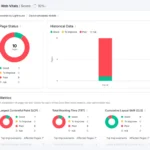
Introduction
Long-form content has become a cornerstone of effective SEO strategies. In 2026, Google and other search engines continue to favor in-depth, authoritative content that satisfies user intent.
Long-form content (typically 1,500–5,000+ words) not only improves rankings but also boosts engagement, builds authority, and generates organic traffic. However, creating long content isn’t enough — it must be optimized for SEO to achieve maximum impact.
This guide will explore strategies, techniques, and actionable tips to optimize long-form content for SEO, ensuring it ranks well and drives measurable results.
1. Start with Keyword Research
Effective SEO begins with keyword research. Long-form content provides the perfect opportunity to target multiple keywords and search intents.
Steps for Keyword Optimization:
- Primary Keyword: Choose a high-value keyword with good search volume and relevance.
- Secondary Keywords: Use related keywords, synonyms, and long-tail phrases naturally throughout the content.
- Search Intent: Identify whether users are looking for information, products, or solutions, and tailor content accordingly.
💡 Example: For a blog on “Long-Form SEO Content Optimization,” include secondary phrases like “SEO content strategy,” “optimize blog for search engines,” and “long-form content best practices.”
2. Structure Your Content for Readability
Long-form content must be easy to read and navigate for both users and search engines.
Key Tips for Content Structure:
- Use Headings (H1, H2, H3): Break content into sections for easier scanning.
- Short Paragraphs: Keep sentences concise and paragraphs 2–4 lines long.
- Bullet Points & Numbered Lists: Highlight key points for quick reading.
- Table of Contents: For very long posts, a clickable table of contents improves UX and SEO.
💡 SEO Tip: Proper heading hierarchy helps Google understand your content and improves chances for featured snippets.
3. Optimize On-Page SEO Elements
On-page SEO ensures that your long-form content is search-engine-friendly.
- Title Tag: Include the primary keyword near the beginning of the title.
- Meta Description: Write a compelling meta description incorporating the main keyword.
- URL Structure: Keep URLs short, descriptive, and keyword-rich.
- Internal Linking: Link to other relevant pages on your website to enhance crawlability.
- External Linking: Link to authoritative sources to increase trust and relevance.
💡 Tip: Tools like Yoast SEO, Rank Math, or SEMrush SEO Writing Assistant can help optimize on-page elements.
4. Write High-Quality, Engaging Content
Google prioritizes content that answers questions comprehensively and engages readers.
Key Strategies:
- Answer User Questions: Use tools like Answer The Public or People Also Ask to discover what users want.
- Use Visuals: Include images, infographics, and videos to enhance understanding and engagement.
- Add Examples & Case Studies: Real-world examples improve credibility.
- Focus on Originality: Avoid duplicate content; add unique insights and perspectives.
💡 Tip: Aim for content that is 10x better than existing top-ranking pages to outrank competitors.
5. Optimize for Featured Snippets and Rich Results
Long-form content provides an opportunity to capture rich search results.
- Use H2/H3 headings that pose questions for snippet opportunities.
- Include bullet points, numbered lists, and tables where appropriate.
- Use schema markup for articles, FAQs, and how-to sections.
💡 SEO Tip: Structured content improves visibility on SERPs and drives more clicks.
6. Enhance User Engagement and UX
Engagement metrics like time on page, bounce rate, and scroll depth impact SEO rankings.
Tips to Boost Engagement:
- Add internal links to related content.
- Use clear CTAs for subscriptions, downloads, or product pages.
- Implement interactive elements like quizzes, polls, or collapsible content.
- Optimize page speed and mobile responsiveness.
💡 Tip: A fast, interactive, and well-structured page encourages visitors to stay longer, signaling value to search engines.
7. Promote and Build Links to Your Long-Form Content
Even the best content needs promotion and backlinks to rank.
- Share on social media channels for traffic and visibility.
- Reach out to industry blogs for guest posts and backlinks.
- Encourage email subscribers to read and share the content.
- Submit content to relevant forums, communities, and Q&A platforms.
💡 Tip: Backlinks from authoritative sites boost both SEO rankings and credibility.
8. Monitor and Update Content Regularly
Long-form content should not be static. Regular updates keep it relevant and maintain rankings.
- Refresh outdated information and statistics.
- Add new sections to cover emerging trends.
- Update internal and external links.
- Track performance metrics in Google Analytics and Search Console.
💡 Tip: Updated content can regain lost rankings and attract new organic traffic.
Our Services SEO Services in Prayagraj | SEO Services in Sasaram | SEO Services in Nawada | SEO Services in Muzaffarpur
FAQs
1. How long should long-form content be for SEO in 2026?
Typically, 1,500–5,000 words performs best, depending on the topic and search intent. The focus should be on comprehensive coverage rather than word count alone.
2. Can long-form content rank faster than short blog posts?
Yes. When optimized properly, long-form content answers questions in depth, increases dwell time, and attracts backlinks, which can help it rank faster and more sustainably.
3. How often should long-form content be updated for SEO?
Aim to review and refresh content every 6–12 months, or sooner if there are industry updates or changes in best practices.
4. Is it necessary to include images and videos in long-form content?
Yes. Visuals enhance engagement, improve readability, and can rank in image search, contributing to higher traffic and user retention.
5. How can I track the SEO performance of long-form content?
Use tools like Google Analytics (traffic, bounce rate, time on page), Search Console (keyword rankings, impressions, clicks), and Ahrefs/SEMrush (backlinks, organic keywords) to monitor performance.
Conclusion
Optimizing long-form content for SEO in 2026 goes beyond just writing lengthy posts. It requires a strategic approach that includes keyword research, content structure, on-page SEO, user engagement, link-building, and continuous updates.
Remember: High-quality, well-optimized long-form content not only ranks higher in search engines but also builds authority, engages readers, and drives long-term organic traffic.





